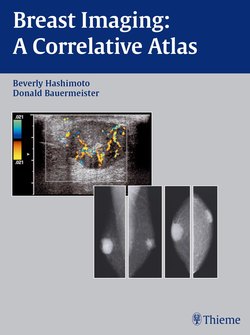Читать книгу Breast Imaging - Beverly Hashimoto - Страница 15
На сайте Литреса книга снята с продажи.
ОглавлениеCase 1
Case History
A 39-year-old woman has just stopped breast-feeding her 10-month-old infant and now finds a new breast lump.
Physical Examination
• left breast: 3 cm lump in the upper outer quadrant
• right breast: normal exam
Mammogram
Mass (Fig. 1–1)
• margin: circumscribed
• shape: oval
• density: fat-containing
Figure 1–1. In the upper outer quadrant of the left breast, there is a well-defined oval mass. (A). Left mediolateral oblique (MLO) mammogram. (B). Left craniocaudal (CC) mammogram.
Ultrasound
Frequency
• 10 MHz
Mass
• margin: well defined
• echogenicity: isoechoic
• retrotumoral acoustic appearance: single edge shadowing
• shape: ellipsoid (Fig. 1–2)
Figure 1–2. Left radial breast sonogram: The mammographic mass identified in Figure 1–1 corresponds to a well-defined mass with heterogeneous echogenicity. Milky fluid was aspirated from this mass.
Pathology
• galactocele
Management
• BI-RADS Assessment Category 2, benign finding
Pearls and Pitfalls
1. Galactoceles are benign milk-filled cysts. This lesion is generally discovered either during or shortly after lactation. Mammographically, galactoceles are well defined, oval, and may appear completely fat density, heterogeneous density, or equal density to glandular parenchyma.
2. Sonographically, galactoceles are hypoechoic, isoechoic, or heterogeneous in echogenicity. Fluid debris levels may be present.
Suggested Readings
1. Salvador R, Salvador M, Jimenez JA, et al. Galactocele of the breast: radiologic and ultrasonographic findings. Br J Radiol 1990;63:140–142.
2. Jackson VP, Jahan R, Fu YS. Benign breast lesions. In: Bassett LW, Jackson VP, Jahan R, Fu YS, Gold RH, eds. Diagnosis of Diseases of the Breast. Philadelphia: WB Saunders Company; 1997:357–443.
